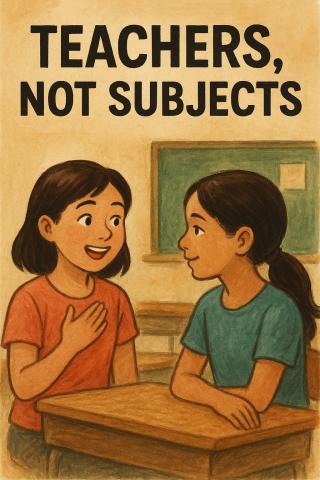
Teachers, Not Subjects
Last week I saw a fourth-grade student confiding with one of her friends who is in grade six. I was overhearing this conversation. She mentioned that there is good news: her math teacher is not there for the whole week and will come back the next week. She was celebrating it. And she added that even greater news is that her replacement is a Hindi teacher and she is very nice. The other girl, who is in the sixth grade, replied, “Oh, that’s fantastic for you! I wish my SST teacher could go for a holiday. I could also have some breathing space.”
I was quite surprised with this conversation that these two students were having. And time and again, it is said in the profession of teaching and learning that children do not like subjects—the like their teachers. And I could see that through the conversation of these two students, it was being established again.
In the classroom, it’s extremely important that the teachers have a very good connection with the students. Then only the learning happens; otherwise, it becomes quite challenging. And this is true, I assume, across the grades. Of course, it is needed more in the early grades, but this is equally important, I think, in the higher grades as well. Even if we reflect and find who were the teachers who taught us very well in the higher grades, we generally remember the teachers who were deeply connected with us—not because they had great knowledge or they could deliver great lectures, but basically because they had a great connection with us. This is how we remember, when we think of a teacher who shaped our journey. It is more because they were deeply connected with us, and less because that particular teacher had strong control over their subject. Of course, subject knowledge is also required, but if we place both on a scale, the ability to connect ranks far higher than mere control over content in the classroom.
But somehow, the way teaching and learning is designed in schools, this becomes extremely challenging for teachers. If we analyze and see how teachers are working in the schools, the time constraints they face, and the number of children they have to attend, it is overwhelming. It appears that the system is designed for teachers to work mechanically. And in that system, which limits them, creates hurdles, and constrains them, even if some teachers are able to establish connections, that is perhaps due to their individual trait and extraordinary capacity.
This is not the system that encourages teachers to be human, to develop that quotient where they can have a great connection with students. So again, both the system and of course teachers, who are by and large the product of that system, kind of stifle teaching and learning by ignoring the fundamental principle of connection in the classroom.
If we sideline it for a moment, and think of a teacher’s work as mechanically operating in the classroom, then the danger is quite visible now. There are real machines which can actually work more efficiently, mechanically, in the classroom, which we call AI. Yet AI has not been able to replace teachers, and perhaps it never can, because a teacher in the classroom builds inter-subjective relationships with students, and it is through these relationships that multiple layers of meaning are created and shared.
So getting back to the original conversation between the two students whom I overheard, they reestablished the age-old known fact that it’s the teacher whom the students like, not the subjects. I think, even though the systems are kind of forcing us to be more mechanical, perhaps it is the teacher’s responsibility and a teacher’s agency to reclaim that. Sometimes it requires resisting a bit, finding some space to develop that connects with the students.
In the end, what matters is not just what we teach, but how we reach. A subject may open doors to knowledge, but it is the teacher’s connection that opens hearts and minds. Systems may continue to create pressures, but within those cracks of resistance lies the real possibility of teaching—where children don’t just learn lessons, they feel seen, heard, and valued. And perhaps, that is the most enduring memory any student carries with them long after the textbooks are gone.
- Log in to post comments
